Category: Agriculture
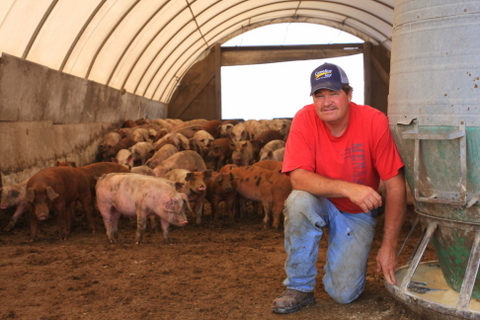
Voice of Reason: Iowa Pork Producer Dave Struthers Offers Top 10 Tips to Speak Up for Ag
With 40 years of hog production under his belt, Iowa pork producer Dave Struthers has seen it all, from pasture production to confinement barns to hoop barns. He’s also willing to help set the record straight about modern pork production and encourages other farmers to do the same.
“There’s a lot of misinformation out there about modern agriculture and livestock production,” said Struthers, a past president of the Iowa Pork Producers Association who farms near Collins. “Since people often don’t take the time to investigate or seek out more information on their own, it’s important for farmers to offer their perspective.”
Here are Struthers’ top 10 tips to help share agriculture’s story:
- Be a voice of reason. Who knows more about the realities of modern agriculture than the farmers who live it every day? “I tell people there are pros and cons of every swine production system,” said Struthers, who runs a farrow-to-finish operation along with a row-crop operation with his family. “I try to offer a practical point of view and provide a voice of reason.” Struthers takes a practical approach when non-farm audiences raise concerns about whether pigs are happy in confinement barns. “What tells me a pig is happy is when it’s healthy and growing,” he said.
- Say yes to opportunities. When the local newspaper, area radio station or major news outlet comes calling, be willing to go on the record, said Struthers, who raises approximately 250 sows and also has hoop barns. Along with participating in many media interviews, Struthers has appeared in the Humane Society of the United States’ documentary film “At the Fork” and has hosted international visitors on his farm. In addition, Struthers and his wife, Elaine, have helped with a bacon festival in San Francisco. “Don’t be afraid to engage,” he said. “It’s good to have these conversations and keep the lines of communication open.”
- Explain what motivates you. Farming is a multi-generation tradition for the Struthers family. “We’re in this for the long haul and care about our animals,” said Struthers, who has raised hogs since he was 9 years old.
- Share your practical experience. This extends from livestock care to nutrient management. “Just explain what you’ve seen and experienced on your farm,” said Struthers, who points out things that are interesting to non-farm audiences, such as the fact that he checks his animals daily and keeps daily observation records of the hogs. “I also explain that swine manure is a valuable asset on our farm,” said Struthers, whose family received the Wergin Good Farm Neighbor award this October. “I note that we soil test every three years and test the manure’s nutrient content, as needed, so fertility is managed properly on our farm.”
- Don’t hold anything back. Struthers is willing to explain the production practices he uses, from confinement barns to biosecurity protocols to tail docking. “Just be open and honest,” he said. Also, acknowledge that farms are complex biological systems, and there are no silver bullets. When asked about various production systems, Struthers addresses the challenges of livestock production in Iowa. “Pigs outdoors are wonderful when it’s 75 degrees and sunny. It’s not so good in freezing rain or snowstorms. Indoors we can create a consistent, comfortable environment and also provide good ventilation and air quality.”
- Be prepared for hot-button issues. Acknowledge that many people are concerned about manure management, water quality and antibiotic and hormone use in livestock production. Struthers explains to non-farm audiences that he only uses hormones when a sow is having trouble giving birth. “I use oxytocin, which is metabolized by the sow’s body and excreted in about 30 minutes,” he said. “I also note that this treatment is similar to Pitocin, the brand name of the hormone oxytocin that women sometimes use to have a baby.”
- Use analogies. Linking farm-specific information to examples that non-farm audiences can relate to is key. Consider antibiotic use in livestock. “I ask people, ‘If your child gets sick, are you going to cross your fingers and hope she gets better? No. You’re going to give her the medicine she needs.’ If antibiotics are required to help a sick pig, it would be contrary to animal well-being not to treat that animal.” Struthers also tells his audiences that all meat at the grocery store is antibiotic-free, since there are mandatory withdrawal times, plus packers conduct tissue tests to make sure the meat is antibiotic-free.
- Help others learn. Be willing to host farm tours, share information through social media and blogs, answer people’s questions and find other ways to help them learn. “Be proactive, and share what you know,” Struthers said. “Become a trusted source of information.”
- Be realistic. Having all the answers isn’t a prerequisite for sharing ag’s story. “If you can’t answer a question, be honest,” Struthers said. “Also, refer the person to Iowa State University, the Iowa Department of Agriculture or other resource that can provide the answer.” In addition, understand that everyone may not agree with your point of view about modern pork production practices, but that’s okay. “It’s progress when these people say, ‘You know, I can see why you’re doing what you’re doing,’” Struthers said.
- Focus on continuous improvement. Struthers is Pork Quality Assurance (PQA) Plus certified, plus his farm has been part of a site assessment to ensure that best-management practices are being followed. Struthers also works closely with his local veterinarian. “I’m always trying to learn more and improve our farming operation,” he said.
Finally, keep connecting with non-farm audiences, Struthers said. “The more you share agriculture’s story, the easier it gets. “
This originally appeared in Farm News, Oct. 2016.
Explore more rural Iowa history
Want to discover more stories and pictures that showcase the unique character of small-town and rural Iowa? Check out my top-selling “Calhoun County” book from Arcadia Publishing, and order your signed copy today.
P.S. Thanks for joining me. I’m glad you’re here.
@Copyright 2016 Darcy Maulsby & Co.
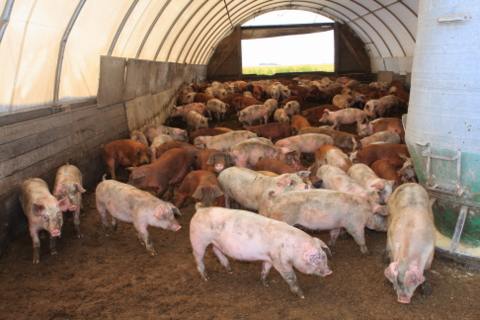
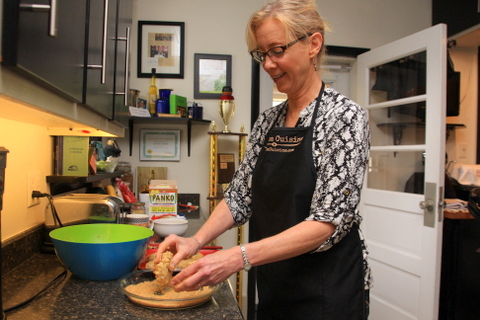
Rustic Cooking Refined: Iowan Robin Qualy Embraces Global Flavors
Call her a fusion of culinary creativity. While Robin Qualy has a strong German heritage, she loves Italian flavors. Although she didn’t care for home ec (now family and consumer sciences) classes during her school years in Lytton, Iowa, this self-taught cook loves to experiment in the kitchen. Most of all, she’s proud of her farm roots but takes a distinctly non-traditional approach to Iowa cooking.
It all started with a magnum of French champagne. “It was a gift from a client in Europe,” said Qualy, a court reporter who lives in Lake City, Iowa. “It sounded fun to have a crab fest with the champagne, so we did.”
The event evolved into a seafood fest with everything from clam chowder to crab cakes with remoulade (pronounced “rem-oo-laud”) sauce. “Finding Emeril Lagasse’s remoulade sauce recipe was a breakthrough,” Qualy said. “While it had 18 ingredients, it showed me why chefs’ food tastes so good, because everything is built up from all those layers of ingredients.”
This also inspired Qualy’s passion for showcasing global flavors. One of her favorite cookbooks is Marcella Hazan’s “Marcella Cucina,” which is filled with Italian recipes and interesting stories. Some of Qualy’s creations, including Pain D’Epi, a wheat-stalk bread inspired by French baguettes, can take on a variety of flavors, from Italian to Greek. This offers her customers options if Qualy happens to be selling her baked goods at the Lake City Farmers Market or the Clear Lake Farmers Market.
Qualy’s goal for this winter? Learn to prepare sushi. Through her part-time business, La Casa Cuisine, where she serves as an in-home guest chef, Qualy also enjoys sharing her best cooking tips, which include “reduce, reduce, reduce” to remove excess moisture and concentrate the flavors in sauces, “fresh, fresh, fresh” for everything from herbs to coffee beans, and “healthify” recipes by using more whole grains and vegetables, less sugar and healthier oils like olive oil.
By adding plenty of vegetables, Qualy “healthified” her chili recipe and took top honors in the 2016 Dell Blair Memorial Chili Cook-Off at Lake City’s fall festival this September. “This contest has been around for a number of years, so I knew I needed to offer something unique,” said Qualy, a first-time competitor. “Since there was no meat in the recipe, I used chipotle peppers in adobo sauce to add a hearty, smoky, spicy base.”
Sharing her culinary creations with friends and family is important to Qualy, who credits her mother, Marlene Glasnapp of Lytton, for inspiring a love of family, food, cooking and baking. Qualy’s advice to other home cooks? “Keep learning, and have fun refining your culinary techniques. Cooking is a skill you can use all your life.”
Savor more Iowa food history
Want more fun Iowa food stories and recipes? Check out my top-selling “Culinary History of Iowa” book from The History Press, and order your signed copy today.
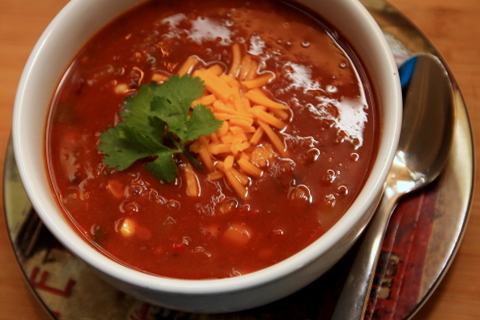 Championship Veggie Chili
Championship Veggie Chili
Robin Qualy’s unique chili won top honors in the 2016 Dell Blair Memorial Chili Cook-Off in Lake City this fall.
2 tablespoons canola oil
1 cup onion, diced
2 cups zucchini with skin, diced
1 / 2 cup red peppers, diced
1 / 2 cup yellow peppers, diced
1 / 2 cup orange pepper, diced
1 / 4 cup poblano or jalapeno pepper, diced (to taste)
2 teaspoons fresh garlic, minced
1/2 teaspoons salt
1/2 teaspoons black pepper
1 tablespoons cumin
2 tablespoons chili powder (to taste)
1 tablespoons sugar
1 box (32 ounces) unsalted vegetable stock (Qualy recommends the Kitchen Basics brand)
28-ounce can crushed tomatoes
28-ounce can garlic-celery-onion stewed tomatoes, diced or mashed
1 can green chilis, diced
2 tablespoons chipotle peppers in adobo sauce, diced
2 ears of sweet corn cut off cob, or 1 cup frozen corn, thawed
14-ounce can each white kidney, red kidney, and black beans – drained, rinsed, and mashed with potato masher
14-ounce can each white kidney, red kidney and black beans – drained and rinsed
In large pot, heat oil over medium heat. Add the onion and zucchini, cook about 5 min., then add peppers and garlic. Cook 5 more minutes. Add salt, pepper, cumin, chili powder and sugar. Cook until onion is translucent and zucchini is soft.
Pour in vegetable stock, crushed tomatoes, stewed tomatoes, green chilis and chipotle peppers in adobo sauce. Bring to boil, then reduce heat. Cover and simmer for 30 minutes. Add sweet corn, mashed beans and whole beans. Stir well; simmer another 30 minutes. Taste and adjust seasoning. Serve with shredded extra-sharp cheddar, snipped cilantro and blue corn chips. Ole! Ole! Ole! Yield: 1 gallon
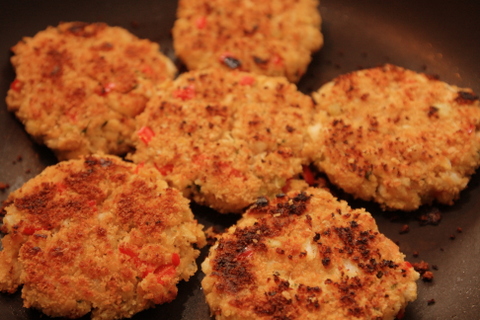 Crab Cakes with Remoulade Sauce
Crab Cakes with Remoulade Sauce
For the crab cakes:
2.5 cups crushed dry bread crumbs
3 6-ounce cans crab meat
1 / 3 cup salad dressing, Miracle Whip or mayo
1 / 2 cup red pepper, diced
2 stalks celery, diced
1 / 3 cup onion, diced
4 shakes of Louisiana hot pepper sauce (to taste)
2 teaspoons Old Bay seasoning
1.5 tablespoons lemon pepper seasoning
1 / 2 teaspoon salt
1 / 2 teaspoon black pepper
2 eggs
2 cups panko bread crumbs
Canola oil to generously coat surface of non-stick skillet
Combine bread crumbs, crab meat, salad dressing, red pepper, celery, onion, hot pepper sauce, Old Bay seasoning, lemon pepper, salt and black pepper. Taste test and adjust seasonings, as desired.
Add 2 eggs, lightly beaten. Form mixture into 10 2.5-inch patties. Firmly coat each crab cake with panko crumbs in pie plate. Heat canola oil until medium hot. Patties should sizzle when touching oil. Fry five patties at a time, 5 minutes per side, or until dark brown. Keep warm until serving with remoulade sauce on the side. Yield: 10 crab cakes
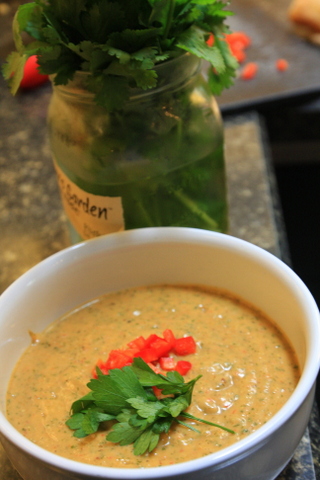 Remoulade sauce
Remoulade sauce
1 cup salad dressing or Miracle Whip
1 / 4 cup ketchup
2 tablespoons extra virgin olive oil
2 tablespoons whole-grain mustard (such as whole-grain Dijon)
2 tablespoons horseradish
1 tablespoon Louisiana hot sauce
2 tablespoon lemon juice
2 tablespoons Worcestershire sauce
1 / 4 cup scallions (or regular onions), diced
1 / 3 cup celery, diced
1 / 2 teaspoon fresh garlic, minced
2 tablespoons fresh parsley, chopped
1 teaspoon Cajun seasoning
1 teaspoon Old Bay seasoning
1 teaspoon dill weed
1 / 2 teaspoon black pepper
2 teaspoons brown sugar
Blend all ingredients, using a blender or food processor with S-shaped chopping/blending blade. Pour into bowl, cover and refrigerate. Best when served at room temperature. Laissez les bons temps rouler! (Let the good times roll!)
Beef Asian Stir Fry
Brown sugar is a secret ingredient in this flavorful stir fry.
1 pound lean steak (charcoal steak is a good option), sliced thinly against the grain into 2-inch-long strips
1 / 3 cup teriyaki sauce (liquid)
2 tablespoons canola oil for stir-frying
2 cups carrots, sliced
1 / 2 cup red peppers, sliced
8 ounces baby bella (cremini) mushrooms (one box), sliced
1 / 3 cup onion, sliced fairly big
1 / 2 of a fresh jalapeno pepper, seeded and deveined, small dice
8 ounces pea pods (can also substitute fresh green beans or broccoli florets)
1 8-ounce can bamboo shoots
1 8-ounce can water chestnuts, sliced
1 can baby corn
1 / 2 teaspoon fresh garlic, minced
1 / 2 teaspoon fresh ginger, grated (keep fresh ginger in freezer)
1 beef & broccoli seasoning packet (usually found near the gravy mixes in the grocery store)
1 cup water
6 tablespoons low-sodium soy sauce
1 / 2 cup teriyaki baste & glaze (thick consistency)
1 tablespoon cornstarch
2 tablespoons brown sugar
Red pepper flakes, as desired, for heat
Chopped cilantro, as desired, for flavor
8 ounces spaghetti, cooked and drained, or cooked rice
Marinate sliced beef in teriyaki sauce for 30 minutes to 1 hour. Heat oil in wok or large skillet to medium high. Add beef and stir-fry until almost fully cooked. Remove and set aside.Add more oil if needed. Stir-fry carrots, red peppers, mushrooms, onion, jalapeno, pea pods, bamboo shoots, water chestnuts and baby corn until crisp-tender. Do not overcook the vegetables.
Note: if fresh green beans are substituted for pea pods, slice the beans on the diagonal. If using broccoli, do not add until the very end. Microwave broccoli until crisp-tender. Using the microwave method allows you to control the broccoli doneness, and keeps it bright green.
Add garlic and ginger, and stir-fry another minute.
In a separate bowl, whisk the contents of the beef & broccoli packet, water, soy sauce, teriyaki thick sauce, cornstarch and brown sugar until combined; add to hot wok mixture. Add beef. Cook until hot and bubbling.
If using spaghetti, stir in drained spaghetti and combine. If using rice, do not combine with stir-fry mixture, but serve separately. Taste and adjust seasonings and heat. Use red pepper flakes or jarred jalapeno juice to increase heat. Top with cilantro, if desired. Serves 4.
 Pain D’Epi—Wheat Stalk Bread
Pain D’Epi—Wheat Stalk Bread
This French-style bread can take on a variety of flavors, depending on the ingredients you add. Break off bite-sized pieces during the meal, and freeze the leftovers.
Prepare baguette dough:
1.5 cups warm water
1.5 tablespoons granulated sugar
1.5 tablespoons olive oil
4 cups bread flour
1 teaspoon kosher salt
2 teaspoons fast-rise (bread machine) yeast
Add ingredients to bread machine; let the machine handle the mixing and first rise.
Spray countertop with cooking oil spray. Take dough out of bread machine and place on counter. Let dough rest 15 min. Divide into three portions.
Greek Pain D’Epi
2 teaspoons olive oil
1 teaspoon Greek seasoning (Cavender’s is a good option)
8 Greek olives (Kalamata olives), sliced
2 tablespoons dry Parmesan cheese
Italian Pain D’Epi
2 teaspoons olive oil
One 6-inch length of fresh rosemary stripped and chopped (or 2 teaspoons dried rosemary)
2 tablespoons dry Parmesan cheese
Roll dough out with rolling pin to 14-inch by 5-inch shape. Pour on olive oil, sprinkle on other ingredients to make either the Greek or Italian Pain D’Epi. (Recipe yields three loaves.)
Roll up dough so it’s 14 inches wide. Pinch to seal. Place dough on parchment-lined 11-inch by 17-inch cookie sheet (up to three bread loaves fit per cookie sheet). Using kitchen shears, make six cuts at a 45-degree angle to within half an inch of bottom of dough. Position each cut dough section in the opposite direction, keeping bottom of dough intact.
Cover with flour-sack cloth, or spray plastic wrap with cooking oil spray and cover. Let dough rise 45 minutes. Place pan in middle of preheated 425-degree oven. Mist inside of oven with water to create steam. Bake for 17 to 23 minutes, or until lightly browned. Serve warm with olive oil for dipping.
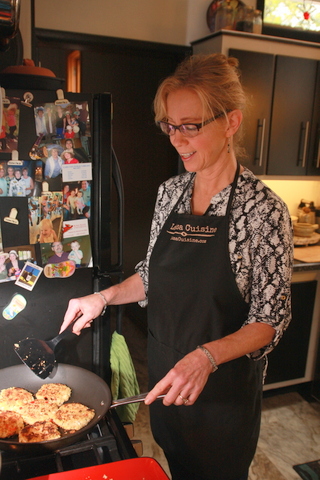 Chicken Piccata
Chicken Piccata
3 tablespoons extra virgin olive oil
2 boneless, skinless chicken breasts, butterflied and pounded to approximately one-quarter inch thickness
Salt and pepper, to taste
Lemon & Butter Cream Sauce for Chicken Piccata
4 tablespoons butter
3 tablespoons shallots, minced
1 pound baby bella (cremini) mushrooms, sliced
1 / 3 cup white wine (Chardonnay is a good option)
1 tablespoon capers
1 / 4 cup lemon juice
1.5 tablespoons cornstarch
1 14-ounce can chicken broth or stock
3 / 4 cup heavy cream or half-and-half
Salt and pepper, to taste
1 pound angel hair pasta, cooked, drained and buttered
Parmesan or asiago cheese
Heat a generous amount of oil in large skillet over medium heat. Salt and pepper the chicken; sauté for approximately three minutes per side. Set cooked chicken aside, covered in foil, on baking sheet in 275-degree oven. Continue sautéing all the chicken and place in oven.
Add butter to drippings in the skillet. Sauté shallots and mushrooms 5 to 7 minutes until browned. Increase heat and add wine, boiling 2 minutes to reduce the liquid. Add capers and lemon juice; simmer two minutes. Dissolve cornstarch in chicken broth and add to pan. Boil mixture down for two to three minutes. Reduce heat and whisk in cream. Simmer until sauce thickens slightly.
Place chicken on pasta and ladle sauce over half the plate, top with Parmesan or asiago cheese.
Serves 4.
This article first appeared in Farm News, Oct. 2016
P.S. Thanks for joining me. I’m glad you’re here.
@Copyright 2016 Darcy Maulsby & Co.

FarmHer #RootedinAg Spotlight–FFA Attracts More Women to Careers in Ag
Heard about FarmHer? It’s a phenomenon that showcases the key roles women play in American agriculture. It’s fun, it’s intriguing, and I was honored to be featured in a #RootedinAg video spotlight on RFD-TV, thanks to Syngenta.
Click here to check out my 30-second FarmHer #RootedinAg spotlight video that appeared on RFD-TV.
Syngenta’s latest issue of Thrive magazine also shared my story in the feature “Open Doors” of how FFA helped me pursue a career in ag. I give the credit to my FFA advisor, Ed Ricks, who showed me the possibilities back when I was a sophomore at Southern Cal High School in Lake City. In the late 1980s and early 1990s, being a girl in FFA was somewhat novel. Now, more young women than ever are involved in FFA, and they are also filling key roles in ag careers.
Here’s my take on this trend, as presented in the feature story and this Syngenta press release:
• Female membership in FFA continues to grow nationwide
• This organization helps women develop leadership skills
These kinds of leadership and communication skills helped prepare me for unique opportunities, such as speaking about Iowa farmers’ perspectives on the 2016 presidential election. See how “stilettos in the cornfield” became a hook when Andrew Ross Sorkin interviewed me on CNBC’s “Squawk Box” to discuss key issues here in rural Iowa from a farmer’s point of view:
FFA attracts more young women to careers in agriculture
GREENSBORO, N.C., Oct. 2016 – When the 2016 National FFA Convention convenes on October 19 in Indianapolis, representatives from Syngenta predict they could see record numbers of female attendees. That’s because female membership in FFA grew from 26 percent during the1992-93 academic year to 44 percent during the 2015-16 academic year. Plus, females have risen to top leadership roles; this year, young women hold five of the six national FFA offices.
“Organizations like FFA and 4-H help foster leadership skills for all participants,” said Jenny Heaton, head of talent management for Syngenta, North America. “As more leadership opportunities open up for young women, these experiences should provide them with more confidence that the agricultural world is ready to accept them as equal partners.”
Megan Moll, a Golden Harvest® Seed Advisor manager at Syngenta, said FFA helped put her on a path to her agricultural career. As a young girl, she loved working on her family’s farm in Michigan. In high school, she became involved in her local FFA chapter by holding different offices and participating in activities, including the National FFA Convention and a leadership conference in Washington, D.C.
“I’m grateful for my FFA experience, because not only did it teach me organizational, team-building and public-speaking skills, but it also built my personal confidence to be able to talk in front of a large group of people,” said Moll. “Everything I learned from FFA has helped me become what I am today.”
Similarly, Darcy Maulsby worked on her family’s farm in Lake City, Iowa, and was an active participant in 4-H during her youth. But she didn’t think about joining FFA until an ag teacher recruited her. Only a few girls were in FFA then, and her experiences proved to be life-changing.
“I look back and think, ‘They were really on top of it for giving us an opportunity to do that,’” said Maulsby. “FFA pushed me in new directions and really helped me grow with communication and leadership skills I have used my entire life.”
Today, Maulsby operates her own ag writing and marketing business on the family farm, where she stays tightly connected to the farm business. She’s also very involved in Farm Bureau, Iowa Corn Growers and Iowa Soybean Association.
“There are a lot of smart women out there transforming agriculture, and it’s exciting to see that change,” Maulsby said. “I definitely encourage young women to get involved in agriculture.”
Syngenta encourages all National FFA Convention attendees to stop by its booth (number), where they can read other stories about being #RootedinAg or tell their own on a special digital wall. For the latest news and trends in agriculture, go to www.syngentathrive.com.
Explore more rural Iowa history
Want to discover more stories and pictures that showcase the unique history of small-town and rural Iowa? Perhaps you’d like a taste of Iowa’s culture and favorite recipes. Check out my top-selling “Culinary History of Iowa” book from The History Press and “Calhoun County” book from Arcadia Publishing, and order your signed copies today.

Talking “Stilettos in the Cornfield,” Taxes, Trade and More on CNBC
What’s on Iowa farmers’ minds regarding the 2016 presidential election? See how “stilettos in the cornfield” became a hook when Andrew Ross Sorkin interviewed me on CNBC’s “Squawk Box” to discuss key issues here in rural Iowa from a farmer’s point of view.
Check out the video here. It all went down on a beautiful fall afternoon on a farm near Linden, Iowa. Proud of Iowa farmers who give a voice to rural America!
Explore more rural Iowa history
Want to discover more stories and pictures that showcase small-town and rural Iowa’s culture and history? Perhaps you’d like a taste of Iowa’s culture and favorite recipes. Check out my top-selling “Culinary History of Iowa” book from The History Press and “Calhoun County” book from Arcadia Publishing, and order your signed copies today.
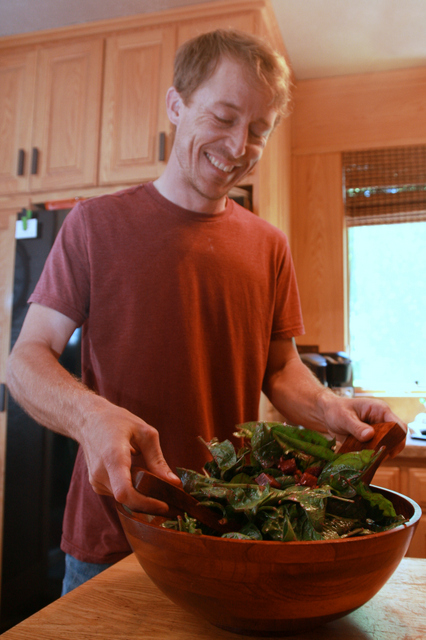
Very Veggie: Iowan’s Farm-Fresh Recipes Offer Guilt-Free Eating
For a guy who didn’t care for vegetables as a kid, Adam Nockels has come a long ways. Now he runs Iowa’s Raccoon Ridge Farm, which specializes in an array of naturally-grown produce.
“My foodie friends in college, including one who is a gardener, got me interested in fresh foods and new flavors,” said Nockels, who was born in Lake City but grew up on military bases before returning to the Lake City area.
Food production also appealed to Nockels, a U.S. Air Force veteran who used the G.I. Bill to attend Iowa State University, where he earned his biology degree in 2010. After completing an internship at Turtle Farm near Granger, where he learned about vegetable production and community supported agriculture (CSA), Nockels knew he wanted to work in production agriculture. When he proposed the idea of starting a farm on the land his family owns between Lake City and Auburn, his grandparents Dennis and Sheila Moulds liked the idea.
“My Grandma Sheila and my mom, Debby, have green thumbs,” said Nockels, who has 10 acres in Raccoon Ridge Farm, which includes 2.5 to 3 acres of vegetables grown with organic practices. “I also like working outdoors and growing healthy food for people.”
Nockels grows a wide variety of crops, including green beans, spinach, lettuce, radishes, strawberries, kale, herbs, squash, peas, potatoes, beets, heirloom tomatoes and more, which he sells at the Lake City Farmers Market and through his weekly CSA deliveries in Lake City, Rockwell City and Carroll. Nockels’ favorite heirloom tomato is the Cherokee Purple Tomato, a flavorful variety that was reportedly gifted to a farmer in Tennessee in the 1890s from Cherokee natives. “Nothing is better than an heirloom tomato,” Nockels said. “For me, it’s either slice, salt and go, or use the tomato in a BLT sandwich.”
Nockels’ weekly newsletters for CSA customers include a list of produce supplied that week, brief descriptions of the unique items in the box, tips for storing the produce, recipes and seasonal cooking tips such as how to roast chile peppers. Some of Nockels most popular items are his green beans. In 2015, the sandy, loamy soils of Raccoon Ridge Farm produced almost 450 pounds of green beans, so full-share holders received roughly 23 pounds of green beans each.
Nockels enjoys experimenting with new recipes, as well as relying on tried-and-true family recipes, to showcase the bounty of the harvest. “When good food is prepared properly, it tastes better. This is guilt-free eating.”
Savor more of Iowa and its food stories, history and more
Want more fun Iowa food stories and recipes? Sign up today for my blog updates and free e-newsletter, or click on the “Subscribe to newsletter” button at the top of my blog homepage.
You can also order my “Calhoun County” Iowa history book, postcards made from my favorite photos of rural Iowa and more at my online store. Thanks for visiting!
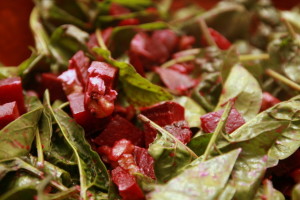
Roasted Beet Salad with Goat Cheese
1 / 4 cup balsamic vinegar
3 tablespoons shallots, thinly sliced
1 tablespoon honey
1/ 3 cup extra-virgin olive oil
Salt and freshly ground black pepper
6 medium beets, cooked and quartered
6 cups fresh greens (spinach, lettuce, arugula, etc.)
1 / 2 cup walnuts, toasted, coarsely chopped
3 ounces soft fresh goat cheese, coarsely crumbled
Line a baking sheet with tinfoil. Preheat oven to 450 degrees
Whisk the vinegar, shallots and honey in a medium bowl to blend. Gradually whisk in the olive oil. Season the vinaigrette to taste with salt and pepper. Toss the beets in a small bowl with enough dressing to coat. Place the beets on the prepared baking sheet, and roast until the beets are slightly caramelized, stirring occasionally, about 12 minutes. Set aside and cool.
Toss the greens and walnuts in a large bowl with enough vinaigrette to coat. Season the salad to taste with salt and pepper. Mound the salad atop four plates. Arrange beets around the salad. Sprinkle with goat cheese. Serve.
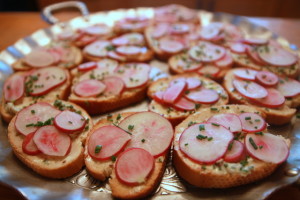
Radish Toast with Sesame-Ginger Butter
4 tablespoons butter, room temperature
3 tablespoons minced chives, divided
1 tablespoon toasted sesame seeds
3 / 4 teaspoon grated peeled fresh ginger
1 / 4 teaspoon Asian sesame oil
16 1 / 4-inch-thick baguette slices, lightly toasted
10 radishes, thinly sliced
Mix butter, 2 tablespoons chives, sesame seeds, ginger and sesame oil in small bowl; season with salt and pepper. Spread butter mixture over each bread slice. Top with radishes, overlapping slightly. Sprinkle with remaining chives.
Spinach Quiche
1 tablespoon butter
2 spring onions, minced
2 bunches spinach, thick stems removed and leaves roughly chopped
Coarse salt and ground pepper
4 ounces Gruyere or Swiss cheese, grated (about 1 cup)
1 frozen pie crust
4 large eggs
1 1 / 2 cups half-and-half
Dash of ground nutmeg
1 teaspoon salt
1 teaspoon pepper
Preheat oven to 350 degrees, with racks set in upper and lower thirds. In a large skillet, heat butter over medium. Add spring onions, and cook, stirring occasionally, until softened, 1 to 2 minutes. Add as much spinach to skillet as will fit; season with salt and pepper, and toss, adding more spinach as room becomes available, until wilted, 2 to 3 minutes.
Transfer spinach mixture to a colander. Press firmly with the back of a spoon to squeeze out as much liquid as possible. Sprinkle cheese onto crust. Spread spinach mixture over shredded cheese.
In a large bowl, whisk together eggs, half-and-half, nutmeg, 1 teaspoon salt and 1 teaspoon pepper. Pour egg mixture into crust.
Bake until center of quiche is just set, 55 to 60 minutes. Let quiche stand 15 minutes before serving.
Cover and refrigerate leftovers up to 1 day. Reheat at 350 degrees until warm in the center, 30 to 40 minutes.
Easy Kale Chips
Preheat oven to 350 degrees. Remove large central stem from kale leaves and tear into chip sized pieces. Drizzle with olive oil and add a sprinkle of salt or seasoned salt. Bake in the oven for 10-15 minutes until leaves edges are brown but not burnt.
Peas and New Potatoes
1 pound new potatoes
1 cup shelled peas
1 tablespoon butter
1 tablespoon flour
Salt and pepper to taste
1 cup milk or half & half
Bring a large pot of water to a boil over high heat. Boil potatoes for 15 to 20 minutes, until tender. Drain.
In a medium saucepan, bring 1 cup water to a boil. Simmer peas in boiling water for 6 to 7 minutes, or until tender (do not overcook). Drain.
Using the same saucepan, melt butter over medium heat. Stir in flour to make a thick paste; gradually whisk in milk, stirring constantly until slightly thickened. Season with salt and pepper to taste. Add potatoes and peas to the sauce; simmer for about 5 minutes, stirring often. Serve immediately.
Crisp Tuna-Cabbage Salad
One 5-ounce can tuna, drained
2 cups finely chopped green or red cabbage, from about 4 ounces or 1 / 4 of a small head of cabbage
1 tablespoon mayonnaise
3 tablespoons plain Greek yogurt
Salt and freshly ground black pepper
Shred the tuna with a fork and mix thoroughly with the cabbage. Stir in mayonnaise and yogurt. Add salt and pepper to taste. Eat immediately, or refrigerate for up to two days. Makes two 1-cup servings.
Basil Pesto
1-2 cups fresh basil leaves
2-4 cloves of garlic
3 / 4 cup good olive oil
1 / 2 cup grated Parmesan cheese
1 / 4 cup pine nuts or walnuts (opt.)
Put basil in blender or food processor. Add garlic, and blend, adding olive oil slowly. Add Parmesan and pine nuts. Blend all into a thick sauce.
This is good over any hot pastas. It can be also added to salad dressing, 1 tablespoon at a time, used as a spread for tomatoes, on crackers, etc. Pesto can also be frozen in small container for use later.
Green Bean and Pasta Salad
4 ounces penne pasta, uncooked (1 1/4 cups)
4 ounces green beans, halved crosswise (about 1 cup)
1 cup canned red or kidney beans, rinsed
1/4 cup chopped fresh flat-leaf parsley
2 tablespoons grated Parmesan (2 ounces)
2 tablespoons olive oil
2 tablespoons fresh lemon juice
Kosher salt and black pepper
Cook the pasta according to the package directions, adding the green beans during the last 3 minutes of cooking. Drain and run under cold water to cool.
Toss the cooled pasta and green beans with the red beans, parsley, Parmesan cheese, olive oil, lemon juice, 1 / 2 teaspoon kosher salt, and 1 / 4 teaspoon black pepper. Divide the salad between two containers and refrigerate for up to one day.
